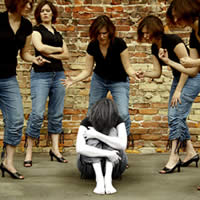Difference between Schizoaffective Disorder and Schizophrenia
Key Difference: Schizoaffective Disorder is a mental condition in which a person exhibits a recurring abnormal mood and psychotic components. The disorder is constant and does not go away. The person may constantly happy and then depressed or they may be a mix of both happy and depressed at the same time. Schizophrenia is a mental disorder that is associated with hallucinations, paranoia, delusions and disorganized speech and thinking. Schizophrenia causes the patient to believe and see things that are usually not there, they may also develop certain characters and scenarios in their head which causes paranoia in the patient.
Schizoaffective Disorder and schizophrenia are often confused to the same because of their similarities in name and nature. However, they are two different mental disorders that can affect a person. They also have similar symptoms but the intensity of the symptoms also differ between the two.

Schizoaffective Disorder is a mental condition in which a person exhibits a recurring abnormal mood and psychotic components. The disorder is constant and does not go away. The person may constantly happy and then depressed or they may be a mix of both happy and depressed at the same time. The disorder causes the patient to loss contact with reality and commonly affects the cognition and emotion. The disorder is known to occur commonly with bipolar or borderline personality disorder. The overlapping of the disorders makes the disorder a little difficult to treat and requires the patient to undergo constant treatment and medication. Schizoaffective Disorder is known to occur more commonly in women than in men.
The exact cause of schizoaffective disorder is unknown. However, different research links the disorder to changes in genes and chemical in the brain. Other research has also been able to link abuse of substances such as marijuana and cannabis in the development and morbidity of psychotic disorders. PubMed Health lists the symptoms as:
- Changes in appetite and energy
- Disorganized speech that is not logical
- False beliefs (delusions), such as thinking someone is trying to harm you (paranoia) or thinking that special messages are hidden in common places (delusions of reference)
- Lack of concern with hygiene or grooming
- Mood that is either too good, or depressed or irritable
- Problems sleeping
- Problems with concentration
- Sadness or hopelessness
- Seeing or hearing things that aren't there (hallucinations)
- Social isolation
- Speaking so quickly that others cannot interrupt you
However, in order to be diagnosed with the condition, DSM criteria states that “there must be a period of at least two weeks of psychosis without mood disorder, and these symptoms cannot be due to medication(s), substance use or another medical condition.” The schizoaffective disorder must be treated as without treatment it could worsen and can even cause a person to commit suicide. Treatment for the condition includes a combination of medicine, psychotherapy and psychosocial rehabilitation focused on symptom management and recovery.

Schizophrenia is a mental disorder that is associated with hallucinations, paranoia, delusions and disorganized speech and thinking. Symptoms of the disease occur in young adulthood and are present during the lifetime of the patient. Schizophrenia causes the patient to believe and see things that are usually not there, they may also develop certain characters and scenarios in their head which causes paranoia in the patient. The patient also believes that the people are trying to harm him or his loved ones and may become violent. People suffering from schizophrenia are believed to also be suffering from additional conditions such as major depression or anxiety disorders.
Schizophrenia is believed to be caused factors such as genetics, early environment, neurobiology, and psychological and social processes. A person is more likely to acquire schizophrenia if the disorder is already present in the family. Many researchers have been trying to link between neurobiology, though there has been no single isolated case between the two. A person suffering from schizophrenia is likely to exhibit symptoms like hallucinations, delusions, disorganized thinking and speech, social withdrawal, sloppiness, less focus on hygiene, loss of motivation, paranoia and lack of attention to certain things. According to the Diagnostic and Statistical Manual of Mental Disorders (DSM-IV-TR), in order for a person to be diagnosed with schizophrenia, he or she must meet three criteria: the patient must have two or more of the listed symptoms during a one-month period, the patient must have a low level of functionality in either social or professional settings and the symptoms or the disorder must occur for at least six months.
There are five different subtypes of schizophrenia as listed by the DSM-IV-TR:
- Paranoid type: Delusions or auditory hallucinations are present, but thought disorder, disorganized behavior, or affective flattening are not. Delusions are persecutory and/or grandiose, but in addition to these, other themes such as jealousy, religiosity, or somatization may also be present.
- Disorganized type: Named hebephrenic schizophrenia in the ICD. Where thought disorder and flat affect are present together.
- Catatonic type: The subject may be almost immobile or exhibit agitated, purposeless movement. Symptoms can include catatonic stupor and waxy flexibility.
- Undifferentiated type: Psychotic symptoms are present but the criteria for paranoid, disorganized, or catatonic types have not been met.
- Residual type: Where positive symptoms are present at a low intensity only.
Schizophrenia can be treated using a combination of medications and therapy including a support group.
Schizoaffective Disorder and Schizophrenia are actually two different conditions. However, schizoaffective disorder is a combination of schizophrenia and major depression. The main difference between the two is that schizoaffective disorder is also associated with periods of depression, while schizophrenia only deals with hallucinations and paranoia.
|
|
Schizoaffective Disorder |
Schizophrenia |
|
Definition |
Schizoaffective Disorder is a medical condition in which a person experiences recurring abnormal mood and psychotic components. |
Schizophrenia is a mental disorder that is associated with hallucinations, paranoia, delusions and disorganized speech and thinking. |
|
Symptoms |
Changes in appetite and energy, disorganized speech that is not logical, false beliefs (delusions), such as thinking someone is trying to harm you (paranoia) or thinking that special messages are hidden in common places, lack of concern with hygiene or grooming, mood that is either too good, or depressed or irritable, problems sleeping, problems with concentration, sadness or hopelessness, seeing or hearing things that aren't there (hallucinations), social isolation, speaking so quickly that others cannot interrupt you. |
Auditory hallucinations, paranoia, delusions, disorganized speech and thinking, social isolation, difficulties in long-term memory, attention, executive functioning, and speed of processing. |
|
Causes |
Most of the causes of this condition are unknown. However, abuse of marijuana and cannabis are being closely linked in the development and morbidity of psychotic disorders. |
Causes of schizophrenia are believed to be caused by genetics, early environment, neurobiology, and psychological and social processes. |
|
Types |
Bipolar type, Depressive type |
Paranoid type, disorganized type, catatonic type, undifferentiated type and residual type. |
|
Treatment |
Conventional treatment for schizoaffective disorder consists of a combination of medicine, psychotherapy and psychosocial rehabilitation focused on symptom management and recovery. Medications include antipsychotic antidepressant, mood stabilizer and benzodiazepines. |
A combination of antipsychotic medications and psychotherapy can help the patient cope with the mental disorder. However, there is no cure for it. |
Image Courtesy: minddisorders.com, drjack.co.uk









Add new comment